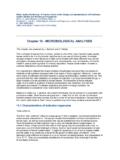Transcription of Biological Phosphorus Removal Processes for Wastewater ...
1 WATER AND Wastewater TREATMENT TECHNOLOGIES - Biological Phosphorus Removal Processes for Wastewater Treatment - A. Sathasivan Biological Phosphorus Removal Processes FOR. Wastewater TREATMENT. A. Sathasivan Department of Civil and Construction Engineering, Curtin University of Technology, Perth WA 6845, Australia. Key Words: Biological Phosphorus Removal , Enhanced Biological Phosphorus Removal (EBPR), Wastewater treatment, Phosphorus , Biological nutrient Removal (BNR). Processes , Phosphorus accumulating organisms (PAOs), Accumlibacter, Competibacter.
2 Contents 1. Introduction S. TE S. 2. EBPR process description 3. Microbiology of PAOs R. AP LS. 4. Biochemical Aspects of EBPR Processes 5. Glycogen Accumulating Organisms and their role 6. Phosphorus Removal observed in other Processes C EO. 7. Parameters controlling EBPR Processes The pH value Temperature Chemical Oxygen Demand (COD)/ Phosphorous Ratio E . Presence Of Electron Acceptors (Nitrate, Oxygen, Or Nitrite) In Anaerobic Zone H. Presence Of Organic Carbon In Aerobic Zone PL O. Dissolved Oxygen (DO) Level In Aerobic Zone Excessive Nitrite In The Aerobic Zone M SC.
3 Presence of Volatile Fatty Acids/Short Chain Fatty Acids Efficiency of Suspended Solids Removal 8. Common Processes adopting EBPR. 9. Recent trends and developments in EBPR Processes SA NE. 10. Modelling EBPR Processes 11. Conclusion Glossary U. Bibliography Biographical Sketch Summary Presence of nutrients, especially nitrogen and Phosphorus in Wastewater effluents and their impacts on natural water bodies are of major concern. With the recent evidence that anthropogenic Phosphorus (not nitrogen) addition in micrograms per litre level can trigger algal growth, Phosphorus Removal to lowest level would become increasingly important.
4 Chemical and Biological means are adopted to remove them. While Phosphorus could be removed chemically, nitrogen Removal is mostly carried out by Biological means. Biological Phosphorus Removal process is popular over chemical means for it's simplicity, economy and various environmental benefits. Biological Phosphorus Removal process relies on enhancing the ability of microorganisms to uptake Encyclopedia of Life Support Systems(EOLSS). WATER AND Wastewater TREATMENT TECHNOLOGIES - Biological Phosphorus Removal Processes for Wastewater Treatment - A.
5 Sathasivan more Phosphorus into their cell. Therefore, these Processes are often referred to as enhanced Biological Phosphorus Removal (EBPR) Processes . EBPR has been implemented worldwide in many Wastewater treatment plants. Despite its promise to provide efficient Phosphorus Removal performance, at times unreliable performance has been reported. In search for answers to such questions many researchers have contributed to the understanding of these Processes in the past fifty years. Although uncertainty still remains to some extent, vast knowledge has been created and put into practice.
6 Fundamentally, proposal of anaerobic/aerobic biochemical pathways and identifying bacteria possibly responsible for EBPR (Candidus Accumlibacter phosphatis) and that could destabilize EBPR (Candidatus Competibacter phosphatis). are major outcomes. Practically, adopting simultaneous nitrification/denitrification and Phosphorus accumulation by supplying very low level of dissolved oxygen in the aerobic zone has been very significant. This has the potential to cut down the cost of operation, while markedly improving the nutrient and carbonaceous matter Removal .
7 Biological means can achieve effluent Phosphorus concentration up to mg/L with S. TE S. average around mg/L. The new requirement will need additional chemical treatment R. AP LS. to further remove Phosphorus to micrograms per litre levels. This paper summarizes the existing knowledge base and provide insight into how they are adopted in practice. C EO. Eutrophication ( , nutrient enrichment due to human activities) in surface waters are primarily due to nitrogen and Phosphorus . The most recognizable manifestations of this phenomena are algal blooms that occur during summer.
8 Over- nutrient enrichment E . results in low dissolved oxygen (DO), fish kills, murky water and depletion of desirable H. flora and fauna. In some cases toxic algae such as microsystis was found in algal PL O. blooms. In addition, the increase in algae increases the need to increase chlorine doses of drinking water, which in turn, leads to higher levels of disinfection by-products M SC. (Fisher et al, 2004; Jack et al., 2002) that have been shown to increase the risk of cancer (Wang et al, 2007). Excessive amounts of nutrients can also stimulate the activity of harmful microbes, such as Pfisteria (Hasselgren et al.)
9 , 2008). SA NE. Approximately 25% of all water body impairments are due to nutrient -related causes ( EPA, 2007). In efforts to reduce the number of nutrient impairments, many point U. source dischargers have received more stringent effluent limits for nitrogen and Phosphorus . To achieve these new, lower effluent limits, facilities have begun to look beyond traditional treatment technologies. There are physical, chemical, and microbiological means of removing nutrients. Biological nutrient Removal Processes remove nitrogen and Phosphorus from Wastewater through the proper use of microorganisms under different environmental conditions.
10 Biological uptake for growth of biomass also removes nitrogen and Phosphorus , but they are not significant. In domestic wastewaters Removal more than this is required and hence other means are needed. The Biological Processes that primarily remove nitrogen are ammonification (conversion of organic nitrogen to ammoniacal nitrogen), nitrification (conversion of ammonia to nitrate) and denitrification (conversion of nitrate to nitrogen gas (N2) which escapes to atmosphere). Despite the traditional belief that algal blooms could be controlled by both nitrogen and Encyclopedia of Life Support Systems(EOLSS).















